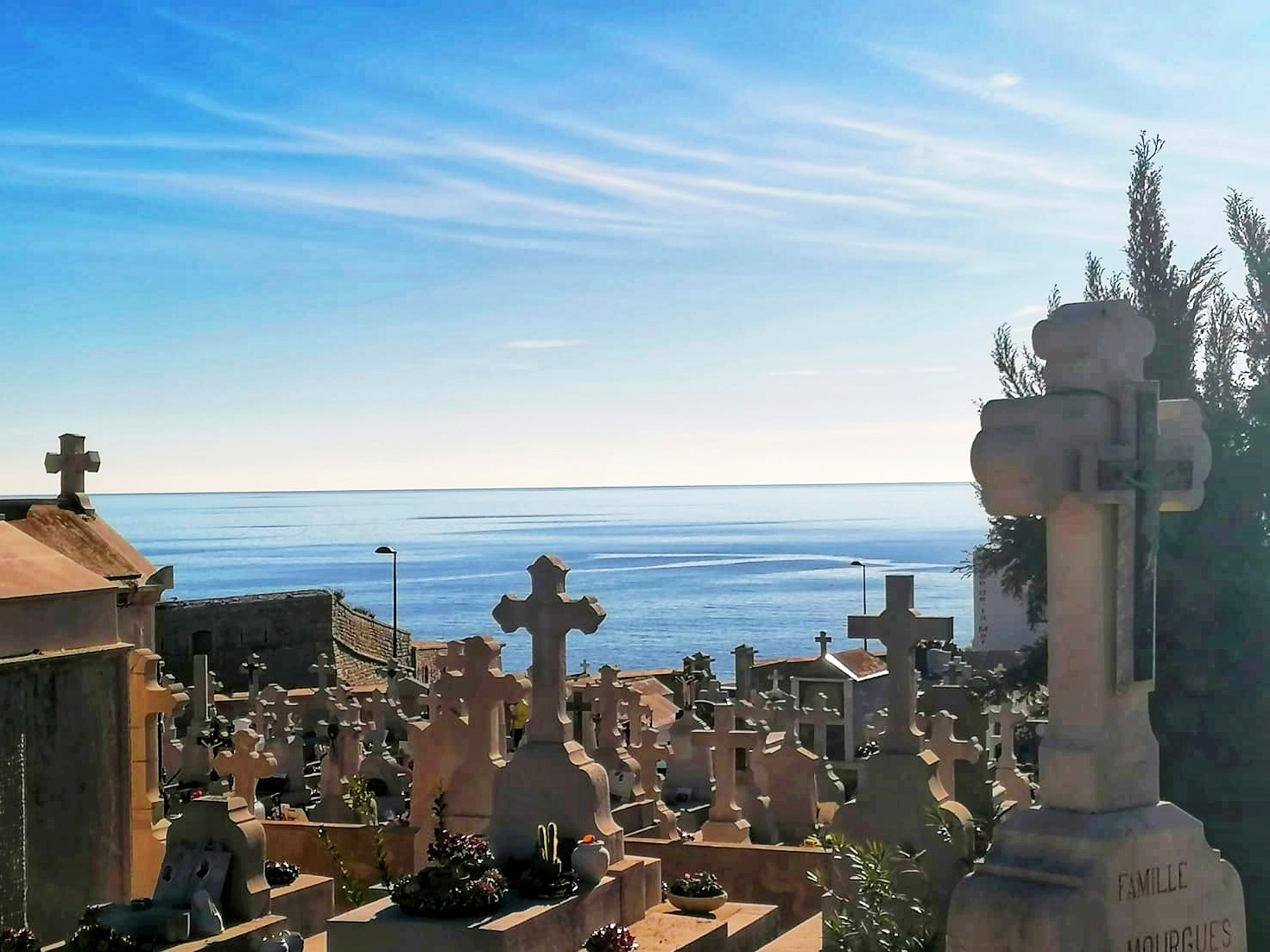Cosy holiday home rentals in Sète, France
Le Pouffre and Le Piade***
Visit Sète’s famous cemeteries
Places of memories and contemplation for the Sète population, the two cemeteries of the unique town also attract numerous tourists and visitors, notably to the tombs of the emblematic Sète singer Georges Brassens and the famous poet Paul Valéry.
The Marine cemetery
Perched on the heights of Mont Saint Clair in the artists’ district, overlooking the port and the Mediterranean Sea, is the Cimitière Marin (Marine Cemetery) formerly known as the Saint Charles cemetery. Created around 1680 as a burial place for the first workers who died during the construction of the Saint-Louis breakwater, the first 1064 m² was developed over the following centuries with a series of plots, including one reserved for the Protestant community, which played an essential role in the growth of the port in the 18th and 19th centuries.

Several tombs recall the maritime history of the town, such as that of the pilots who disappeared while rescuing a ship in distress or that of the young midshipman Eugène Herber killed in Beijing in 1900. Others bear witness to the notoriety of Sète personalities, such as the politician Mario Roustan, the French actor and director Jean Vilar, the jouster Vincent Cianni, known as “the man of a hundred victories” and the filmmaker Henri Colpi. But the most famous personality is Paul Valéry, a French poet, essayist and philosopher who died on July 20, 1945 and was buried in this cemetery in the tomb of his ancestors.
The Saint-Charles cemetery was renamed Le Cimitière Marin on 7 August 1945 in respectful homage to the famous poem by Paul Valéry, Le Cimitière Marin, published in 1920.
The famous poem by Paul Valéry: Le Cimitière Marin
In one of Paul Valéry’s most moving 24-verse poems, the narrator observes the calm sea under the blazing midday sun and accepts the inevitability of death. But, as the wind begins to stir and waves begin to form on the sea, a sign of the energy beneath the surface, the narrator proclaims the necessity of choosing life by choosing eternal change over contemplation.
“LE CIMETIÈRE MARIN, Paul Valéry 1920
Ce toit tranquille, où marchent des colombes,
Entre les pins palpite, entre les tombes ;
Midi le juste y compose de feux
La mer, la mer, toujours recommencée !
Ô récompense après une pensée
Qu’un long regard sur le calme des dieux ! … “
The poem is evoked by Georges Brassens in his 1996 song “Supplique pour être enterré à la plage de Sète” (Plea to be buried at the beach of Sète). Brassens also pays homage to Paul Valéry with a verse: “Et c’est la mort, la mort, toujours recommencée” in his text “Mourir pour des idées”.
Paul Valery Museum
Just behind Marine Cemetery boasting an exceptional view and location, is the Paul Valéry Museum, a restored 1970s Corbusian-style building hosting collections of beaux arts paintings and drawings. The Paul Valéry Museum brings together more than 7,000 works. In addition to the Fine Arts collections, which include more than 730 paintings and nearly 2,900 drawings, the museum has three specific collections: the Paul Valéry collection, the Salah Stétié collection and a collection of Popular Arts and Traditions.
The surrounding gardens host outdoor events including conferences, literary encounters (notably “Les Journées Paul Valéry”, every year in September), poetry, recitals and concerts, which reflect the Mediterranean identity of the town of Sète. The cafe serves delicious food and drink, which can be enjoyed on the terrace overlooking the grounds and the sea.
Visit the Paul Valéry Museum, 148 Rue François Desnoyer, 34200 Sète; Tel.: +33 (0)4 99 04 76 16 ; https://museepaulvalery-sete.fr/
Le Py cemetery: Georges Brassens’ final resting place
Le Py Communal Cemetery, formerly known as the cemetery of the poor, is in the northern area of the town with the main entrance located on the Boulevard Camille Blanc. Officially consecrated as soon as it opened in 1877 to Saint Lazarus, this cemetery is better known simply as “Py”.

With stunning views over the Thau Laguna towards Balaruc, Bouzigues and Mèze, its military squares perpetuate the acts of courage shown by many young soldiers from Sète and also foreigners during the First and Second World Wars as well as those of decolonization. Beneath its tall cypresses, other graves preserve the memory of personalities who have contributed to the fame of the town of Sète, such as the actor Lucien Barjon, the footballer Yvan Beck, the actor Alfred Nakache and the politician Lucien Salette. The most famous, however, is Georges Brassens, a singer-songwriter, born on 22 October 1921 in a popular district of the port of Cette (the name of the city was not spelt Sète until 1928) who died on 29 October 1981.
In 1966, Georges Brassens recorded his testament song “Supplique pour être enterré à la plage de Sète” (Plea to be buried at the beach of Sète) where he dreamed of being laid to rest on a beach in the town of Sète. Impossible to be buried under a dune, his body lies in the family vault beneath a cypress tree opposite the Espace Georges Brassens in Le Py cemetery.
Georges Brassens’ grave is much visited every year. The grave itself contains very few significant elements; none-the-less, it seems to play several important roles for his admirers: it enables them to be close to the body of the artist and demonstrate their attachment to him as they might have done by attending one of his concerts; it also confirms the coherence between the values he put forward as a singer and those he embodied as a man; lastly it gives a strong emotional strength to the revival of admirers’ memories of Brassens.
George Brassens Museum
Facing the Py Cemetery is the George Brassens Museum. Adorned with headphones, the voice of George Brassens guides you through the museum, whispering secrets in your ear about his life and his artistic career, his youth among friends in Sète, going to Paris, and his early days as an artist, a poet and a music writer. An exhibition retraces the singer’s encounters with women. More than half of his repertoire is dedicated to the female gender and to Püppchen, the woman who shared his life, his muse, his goddess, his eternal fiancée, the one for whom he wrote his greatest titles including “La non demande en mariage“.
You will experience an intimate moment charged with emotion as you enter the poet’s world!
Audio guide in English, Spanish, Italian and German.
Audio guide suitable for children.
Note: All photos are the property of Leigh and Mehdi Kamraoui and lepouffre.com. They are not free royalty free.
